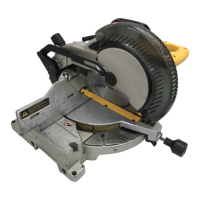8
English
FIG. 14
TRIGGER
SWITCH
HOLE FOR PADLOCK
LEFT SIDE
FENCE
CLAMPING
KNOB
FIG. 13
LEFT SIDE
BEVEL STOP
SCREW
(Figure 18) of your project and locate that angle on the
appropriate arc in the chart. From that point follow the chart
straight down to find the correct bevel angle and straight
across to find the correct miter angle.
Set your saw to the prescribed angles and make a few trial
cuts. Practice fitting the cut pieces together until you develop
a feel for this procedure and feel comfortable with it.
Example: To make a 4 sided box with 26° exterior angles
(Angle A, Figure 18), use the upper right arc. Find 26° on
the arc scale. Follow the horizontal intersecting line to
either side to get miter angle setting on saw (42°).
Likewise, follow the vertical intersecting line to the top or
bottom to get the bevel angle setting on the saw (18°).
Always try cuts on a few scrap pieces of wood to verify
settings on saw.
MITER SCALE
The scale is used when calculating angles. To calculate
the proper miter angle, divide 180 degrees by the number
of sides of the box or frame. Refer to the chart on page 7
for some examples.
VERNIER SCALE (PICTURE ON PAGE 11)
Your saw is equipped with a vernier scale for added
precision. The vernier scale allows you to accurately set
miter angles to the nearest 1/4 degree (15 minutes). To
use the vernier scale follow the steps listed below.
(As an example, let’s assume that the angle you want to
miter is 24-1/4 degrees right).
1. Turn off miter saw.
2. Set the miter angle to the nearest whole degree desired
by aligning the center mark in the vernier scale, shown in
figure V1, with the whole degree number etched in the
miter scale. Examine Figure V1 closely; the setting
shown is 24 degrees right miter.
3. To set the additional 1/4 degree, squeeze the miter arm
lock and carefully move the arm to the RIGHT until the
1/4 degree vernier mark aligns with the CLOSEST
degree mark on the miter scale. In our example, the
closest degree mark on the miter scale happens to be 25
degrees. Figure V2 shows a setting of 24-1/4 degrees
right miter.
For settings that require partial degrees (1/4, 1/2, 3/4
degrees) align the desired vernier mark with the
CLOSEST degree mark on the miter scale, as described
above. (The plastic vernier plate is inscribed with marks
for 1/4, 1/2, 3/4 and 1 degrees. Only the 1/2 degree is
numerically labeled.)
WHEN MITERING TO THE RIGHT
To increase the miter angle when mitering to the right,
move the arm to align the appropriate vernier mark with
the closest mark on the miter scale to the right. To
decrease the miter angle when mitering to the right, move
the arm to align the appropriate vernier mark with the
closest mark on the miter scale to the left.
WHEN MITERING TO THE LEFT
To increase the miter angle when mitering to the left, move
the arm to align the appropriate vernier mark with the
closest mark on the miter scale to the left. To decrease the
miter angle when mitering to the left, move the arm to align
the appropriate vernier mark with the closest mark on the
miter scale to the right.
CUTTING BASE MOLDING
ALWAYS MAKE A DRY RUN WITHOUT POWER
BEFORE MAKING ANY CUTS.
Straight 90 degree cuts :
Position the wood against the fence as shown in Figure
20. Turn on the saw, allow the blade to reach full
speed and lower the arm smoothly through the cut.
CUTTING BASE MOLDING UP TO 3-1/2" HIGH
VERTICALLY AGAINST THE FENCE
Position molding as shown in Figure 21.
All cuts are made with the back of the molding against the
fence and bottom of the molding against the base.
INSIDE CORNER:
Left side
1. Miter left 45°
2. Save left side of cut
Right side
1. Miter Right 45°
2. Save right side of cut
OUTSIDE CORNER:
Left side
1. Miter right at 45°
2. Save left side of cut
Right side
1. Miter left at 45°
2. Save right side of cut
Material up to 3.5" (3-1/2)" can be cut as described above.
For wider boards [up to 4.25" (4-1/4")] several minor
concessions must be made.
When cutting a board between 3.5" (3-1/2") and 4.25"
(4-1/4") in width the roller on the tip of the guard could
hang up on the workpiece. If this occurs, simply place your
right thumb on the upper side of the guard and roll the
guard up just enough to clear the workpiece, as shown in
Figure 24. Once you have cleared the workpiece, you can
release the guard and it will continue to open as the cut
progresses.
When mitering to the right side of a base molding wider
than 3.5" (3-1/2") standing vertically against the fence as
in Figure 21, the saw can only cut through the board up to

